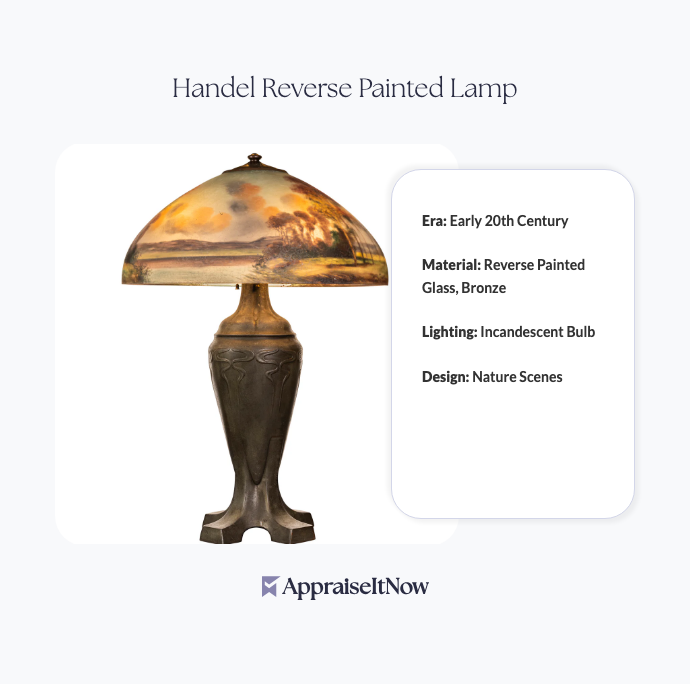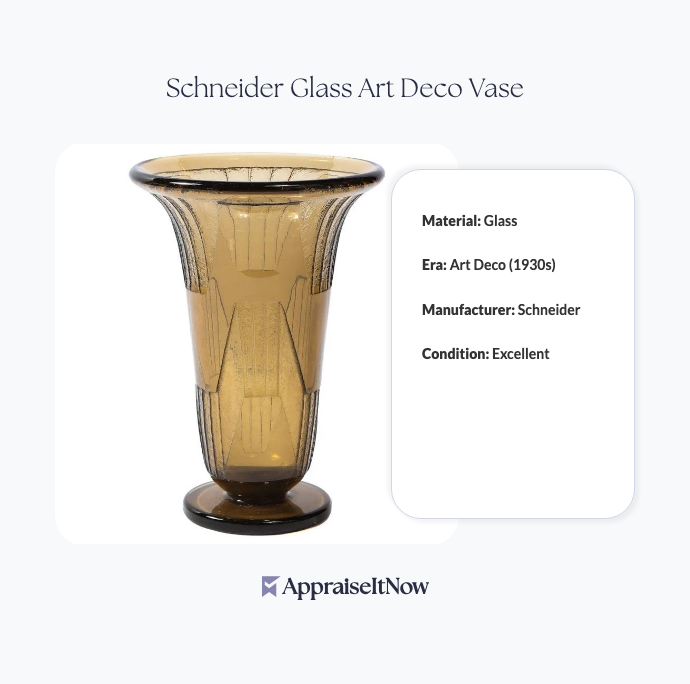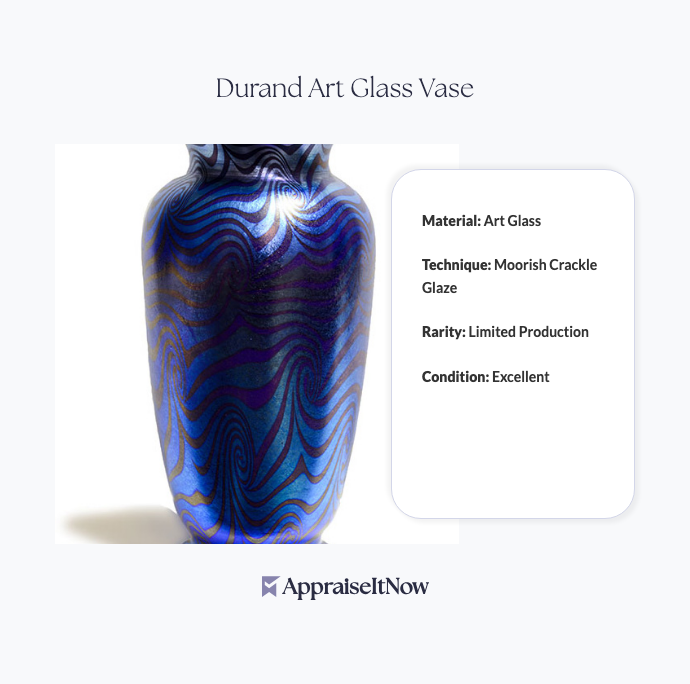<h1>How to Get Your Handel Reverse Painted Lamp Appraised</h1>
<p>If you've inherited a stunning Handel reverse painted lamp or recently acquired one, you likely want to understand its true value. These exceptional lighting fixtures, produced during the early 20th century, command significant collector interest and can appraise for <strong>$6,000 to $10,000</strong> depending on condition, provenance, and specific characteristics. A professional appraisal provides the documentation and confidence you need, whether you're considering selling, seeking insurance coverage, or simply verifying your collection's worth.</p>
<h2>What Makes a Handel Lamp Valuable</h2>
<p>Your Handel lamp represents more than decorative lighting—it's a piece of American artistic craftsmanship from a golden era of design. Handel & Company, operating from its Connecticut factory, produced these lamps beginning in 1910 with a commitment to artistic excellence that distinguishes them in the antique lighting market today.</p>
<p>The reverse painting technique is fundamental to understanding your lamp's appeal and value. Unlike traditional painted surfaces, reverse painting involves creating images on the interior surface of glass panels, allowing light to pass through and illuminate the scene from within. This creates a luminous, almost ethereal quality that contemporary collectors find irresistible. Scenes typically depicted nature subjects—landscapes, forest views, lakeside settings—rendered with remarkable detail and artistic skill.</p>
<p>Production scarcity dramatically affects value. Handel & Company manufactured only approximately <strong>500 pieces worldwide</strong> during their peak production years, making each surviving example increasingly rare. This limited output, combined with the fragile nature of reverse-painted glass, means finding an intact example in good condition commands premium pricing in today's <a href="/types/memorabilia-and-collectibles">memorabilia and collectibles</a> market.</p>
<div class="callout tip"><p><strong>Collector's Insight</strong></p>
<p>Lamps with documented artist signatures or rare scenic subjects often command 15-25% premiums over standard examples, making authentication through professional appraisal especially valuable.</p></div>
<h2>Identifying Authentic Handel Reverse Painted Lamps</h2>
<p>Before seeking appraisal, understanding how to identify a reverse painted lamp shade helps you evaluate what you own. Genuine Handel lamps display specific identifying characteristics that distinguish them from reproductions or similar period pieces.</p>
<p><strong>Authentic Handel lamps feature:</strong>
- Bronze or brass fittings with patina consistent with early 20th century manufacture
- Hand-painted reverse glass panels showing individual artistic variation
- Clear Handel Company markings on the base or metal framework
- Multiple glass panels fitted seamlessly into supporting metalwork
- Weight and construction quality reflecting period craftsmanship</p>
<p>Examining the paint application from both sides reveals the reverse technique—from the exterior you see finished images, while the interior shows the painting process with visible brushwork. This characteristic distinguishes authentic Handel work from painted-exterior imitations that flood the market.</p>
<h2>Condition Factors That Drive Appraisal Values</h2>
<p>How to tell if a lamp is worth money requires evaluating multiple condition elements. Your Handel lamp's appraisal value reflects the interplay between its artistic merit, rarity, and physical condition.</p>
<table class='appraisal-table'>
<thead>
<tr>
<th>Condition Grade</th>
<th>Estimated Value</th>
<th>Key Characteristics</th>
</tr>
</thead>
<tbody>
<tr>
<td>Excellent (95%+)</td>
<td>$8,500-$10,000</td>
<td>Original finish, no paint loss, fully functional</td>
</tr>
<tr>
<td>Very Good (80-94%)</td>
<td>$7,000-$8,500</td>
<td>Minor paint fading, intact glass, working condition</td>
</tr>
<tr>
<td>Good (60-79%)</td>
<td>$5,500-$7,000</td>
<td>Noticeable paint loss, possible minor repairs, functional</td>
</tr>
<tr>
<td>Fair (Below 60%)</td>
<td>$4,000-$5,500</td>
<td>Significant damage, restoration needed, limited appeal</td>
</tr>
</tbody>
</table>
<p>The condition assessment process examines paint integrity on each glass panel, checking for fading, flaking, or loss that diminishes the visual impact. Even minor imperfections affect value since the reverse-painted glass cannot be easily repaired without destroying the artistic work. The brass or bronze base requires evaluation for structural integrity, original patina, and any previous repairs or replacements.</p>
<h2>How to Tell if a Lamp is Vintage</h2>
<p>Understanding how to tell if a lamp is vintage helps you verify what you own before appraisal. Handel lamps from the 1910-1930 period display construction methods and materials distinctly different from modern reproductions, though careful examination is necessary to distinguish them from other quality period pieces.</p>
<p>Vintage Handel characteristics include handmade glass panels with slight variations in thickness and tone, indicating individual artisan creation rather than industrial uniformity. The metal framework shows appropriate patina and wear patterns—a smooth, dark oxidation on bronze rather than bright polishing or artificial aging. Original electrical components, if present, reflect period standards with cloth-wrapped wiring and simple switch mechanisms.</p>
<p>The construction method itself reveals age. Genuine Handel lamps feature glass panels individually fitted and secured within metal frameworks, with solder joints and mechanical fasteners visible upon close inspection. Modern reproductions often employ adhesives or simpler assembly techniques incompatible with authentic period construction.</p>
<h2>Understanding Your Lamp's Vintage Era</h2>
<p>What did lamps look like in the 1920s? This common question helps contextualize your Handel lamp within design history. By the 1920s, Handel's reverse painted lamps represented sophisticated artistic lighting, distinct from simpler contemporary fixtures. The company had refined production techniques, expanded its scenic palette, and established itself as a premium lighting manufacturer.</p>
<p>Design evolution matters. Earlier Handel lamps from 1910-1915 featured simpler forms and smaller panels. Mid-period pieces (1915-1925) showcase fuller designs with multiple panels and more ambitious scenic compositions. Later examples (1925-1930) often display Art Deco influences alongside traditional landscape themes. Identifying your lamp's production period helps establish its place within design history and supports valuation through professional <a href="/types/antique-artwork">antique artwork</a> appraisal specialists.</p>
<h2>Market Demand and Collector Interest</h2>
<p>Do vintage lamps sell well? Absolutely—particularly quality examples like your potential Handel piece. The antique lighting market has experienced consistent appreciation over the past decade, driven by interior designers seeking authentic period fixtures and serious collectors specializing in early 20th-century decorative arts.</p>
<p>Who buys Handel lamps? Your potential market includes sophisticated collectors of American decorative arts, interior designers furnishing period homes or upscale commercial spaces, museums acquiring examples for permanent collections, and investors recognizing these pieces as tangible asset values. This diverse buyer base supports strong market conditions and relatively quick sales for authenticated examples.</p>
<p>The question "How do vintage lamps sell well?" has a straightforward answer: through channels that reach serious collectors. Auction houses specializing in decorative arts, established antiques dealers with clientele seeking premium pieces, and direct sales to collectors generate the strongest prices and fastest transactions. Professional appraisals facilitate these sales by providing documented provenance and verified valuations that sophisticated buyers expect.</p>
<div class="callout note"><p><strong>Market Insight</strong></p>
<p>Handel lamps consistently appreciate 3-5% annually, outpacing general antiques inflation due to limited supply and sustained collector demand.</p></div>
<h2>Geographic and Regional Value Variations</h2>
<p>Appraisal values can reflect regional variations based on collector density and local market conditions. Areas with strong Arts & Crafts and Art Nouveau collecting communities—particularly the Northeast and Pacific regions where Handel lamps were historically most popular—tend to support premium pricing. Your specific location may affect the final appraisal value, though a certified professional appraiser will account for these regional factors.</p>
<h2>Preparing Your Lamp for Professional Appraisal</h2>
<p>To maximize the accuracy and comprehensiveness of your appraisal, gather available documentation before meeting with a professional evaluator. This might include original purchase receipts, previous appraisals, family history or provenance information, and detailed photographs showing the lamp from multiple angles, including base markings and signatures.</p>
<p>Clean your lamp appropriately before appraisal—gentle dusting with soft cloths is acceptable, but avoid aggressive cleaning that might damage patina or remove identifying marks. Document any repairs or restoration work previously performed, as this information affects valuation and authentication.</p>
<p>When selecting an appraiser, look for credentials from established organizations like the American Society of Appraisers (ASA) or International Society of Appraisers (ISA) with specific expertise in decorative arts and <a href="/types/antique-furniture">antique furniture</a>. Professional appraisers understand the subtleties of Handel authentication and can provide detailed condition assessments that support insurance coverage, estate planning, or sales transactions.</p>
<h2>Where Handel Lamps Were Made</h2>
<p>Understanding manufacturing context strengthens appreciation for your lamp's value. Handel & Company operated from its factory in Meriden, Connecticut, a manufacturing hub that attracted skilled artisans and craftspeople. The company maintained strict quality standards, employing talented glass painters and metalworkers who collaborated to create these exceptional pieces. This geographic concentration and documented craftsmanship enhance authentication and support valuations compared to lamps of uncertain origin.</p>
<h2>The Professional Appraisal Advantage</h2>
<p>Obtaining a certified appraisal from specialists in decorative arts and <a href="/types/personal-property">personal property</a> provides multiple benefits beyond simple valuation. Professional appraisers create detailed condition documentation using standardized photography and written descriptions, establishing baseline information for insurance purposes or future reference. They verify authenticity using comparative analysis with documented examples, maker's marks, construction techniques, and historical records that individual owners cannot replicate.</p>
<p>For insurance purposes, USPAP-compliant appraisals provide documentation insurers require for coverage determinations. If you need to include your Handel lamp in estate planning, a professional appraisal establishes fair market value for tax and distribution purposes. Should you decide to sell, a certified appraisal supports your asking price and facilitates transactions with serious collectors who expect professional documentation.</p>
<p>Services like <strong>AppraiseItNow</strong> connect you with credentialed appraisers offering comprehensive valuations for decorative arts and <a href="/types/household-goods">household goods</a>. Our network includes specialists across the U.S. with expertise in period lighting, reverse-painted glass techniques, and early 20th-century manufacturing, ensuring your Handel lamp receives thorough, accurate evaluation.</p>
<div class="callout note"><p><strong>Key Takeaway</strong></p>
<p>A certified appraisal of your Handel reverse painted lamp provides essential documentation for insurance, estate planning, or sale purposes, while confirming the craftsmanship and historical significance that positions these exceptional fixtures in today's competitive collector market. Whether your lamp values at $6,000 or reaches the $10,000 ceiling, professional evaluation ensures you understand both its artistic merit and monetary worth.</p></div>







.avif)







